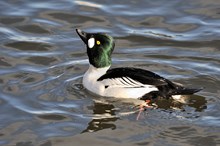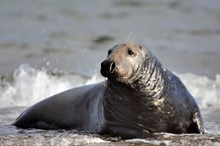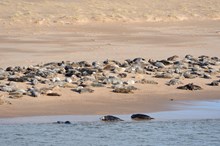21 December, 2020
More people flock to NE Scotland’s national nature reserves in 2020

NatureScot’s North East National Nature Reserves (NNRs) saw an upsurge in visitors in 2020, as part of over a million estimated visitors to NNRs across Scotland. The figure is an increase from an estimated 650,000 in recent years.
The increase, initially due to lockdown, was followed by continued interest and enthusiasm across the nation for spending time in nature in this difficult year.
Winter is a wonderful time to continue that habit. There’s plenty to see on nature reserves in the North East, from whooper swans to grey seals to deer, and they’re often easier to spot at this time of year because of the bare trees.
NatureScot Chief Executive Francesca Osowska said: “People throughout Scotland have been enjoying spending time outdoors more than ever in 2020. Nature is helping us all cope with anxiety throughout this difficult time and strengthening our resilience. I’d encourage people to get out and enjoy their local national nature reserves over the holiday season, following the latest government guidelines. Our nature reserve staff have highlighted some spectacular sights to see on our reserves this winter.”
Whooper swans fly from Iceland and overwinter at both Muir of Dinnet and Forvie reserves. Known as ‘singing swans’ in several European languages, after their bugling call, they are one of the highest-flying birds in the world and have been seen from commercial jet liners.
Also at Forvie, the Ythan Estuary is buzzing with birdlife: the swans, as well as pink-footed geese from Iceland and a myriad of waders and ducks from Arctic regions gather here. Lucky visitors might cross paths with an otter at dawn or dusk – try Waulkmill hide or Waterside Bridge. The number of grey seals will gradually increase over the winter; be sure to view them from across the river at Newburgh beach to avoid disturbance.
Offshore, you may catch a glimpse of a harbour porpoise on a calm day, while the local herring gulls are worth keeping an eye out for, as well as for the rare, ghostly-pale Iceland gull from the north-west – two have been sighted recently near Hackley Bay. On the moor, roe deer can be seen with relative ease, while the lichens on the heath form a patchwork pattern among the dormant plants. Meanwhile, look out for little flocks of snow buntings and twite among the dunes in the south of the reserve.
At Muir of Dinnet reserve, watch for fieldfare, large colourful thrushes, which arrive in late autumn, often in large, noisy bickering flocks. They have a loud tak-tak-tak call. A flock of fieldfares stripping a rowan tree is an amazing sight. They come here to escape the worst of the winter in Scandinavia, where they nest communally and have an unusual form of defence: any invader into a fieldfare colony will be defecated upon, which can be fatal to birds as it destroys the waterproofing of their feathers, leaving them vulnerable to soaking and chilling to death.
Believe it or not, some of the wildlife is already looking towards spring at Dinnet. On fine days in December, tits explore holes they may nest in next year and many of the ducks are already displaying, in the drive to find a mate. The goldeneye are in full swing already, and woodpeckers often start to drum in January.
Francesca has some final words of advice for those visiting nature reserves: “It’s been amazing to see so many people enjoying our reserves this year, but we’d also like to remind people to protect our reserves for future generations. For example please don’t litter or light campfires, as these can damage plants, trees and wildlife.”
ENDS
Contact information
- Name
- NatureScot Media
- Telephone
- 0131 316 2655
- media@nature.scot
Notes to editors
There are 43 National Nature Reserves in Scotland. These are special places that look after some of the best of Scotland’s nature on behalf of everyone who lives or visits Scotland, and they provide unique opportunities to visit, enjoy and learn more about Scotland’s nature. For more information, see see https://www.nature.scot/enjoying-outdoors/scotlands-national-nature-reserves
NatureScot is Scotland's nature agency. We work to enhance our natural environment in Scotland and inspire everyone to care more about it. Our priority is a nature-rich future for Scotland and an effective response to the climate emergency. For more information, visit our website at www.nature.scot or follow us on X at https://x.com/NatureScot
’S e NatureScot buidheann nàdair na h-Alba. Bidh sinn a’ neartachadh àrainneachd na h-Alba agus a’ brosnachadh dhaoine gu barrachd suim a chur ann an nàdar. Tha e mar phrìomhachas againn gum bi nàdar na h-Alba beairteach agus gun dèilig sinn gu h-èifeachdach le èiginn na gnàth-shìde. Tha an tuilleadh fiosrachaidh aig www.nature.scot no air X aig https://x.com/NatureScot





